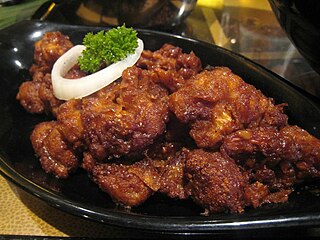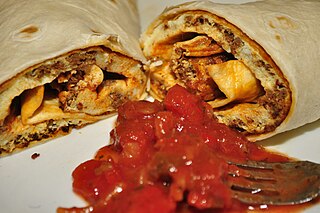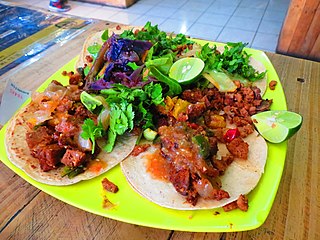
Fusion cuisine is a cuisine that combines elements of different culinary traditions that originate from different countries, regions, or cultures. Cuisines of this type are not categorized according to any one particular cuisine style and have played a part in many contemporary restaurant cuisines since the 1970s.

Moroccan cuisine is the cuisine of Morocco, fueled by interactions and exchanges with many cultures and nations over the centuries. Moroccan cuisine is usually a mix of Arab, Berber, Andalusi, and Mediterranean cuisines, with minimal European and sub-Saharan influences. Like the rest of the Maghrebi cuisine, Moroccan cuisine has more in common with Middle Eastern cuisine than with the rest of Africa.

Tex-Mex cuisine is a regional American cuisine that originates from the culinary creations of Tejano people. It has spread from border states such as Texas and others in the Southwestern United States to the rest of the country. It is a subtype of Southwestern cuisine found in the American Southwest.

Canadian cuisine consists of the cooking traditions and practices of Canada, with regional variances around the country. First Nations and Inuit have practiced their culinary traditions in what is now Canada for at least 15,000 years. The advent of European explorers and settlers, first on the east coast and then throughout the wider territories of New France, British North America and Canada, saw the melding of foreign recipes, cooking techniques, and ingredients with indigenous flora and fauna. Modern Canadian cuisine has maintained this dedication to local ingredients and terroir, as exemplified in the naming of specific ingredients based on their locale, such as Malpeque oysters or Alberta beef. Accordingly, Canadian cuisine privileges the quality of ingredients and regionality, and may be broadly defined as a national tradition of "creole" culinary practices, based on the complex multicultural and geographically diverse nature of both historical and contemporary Canadian society.

Moqueca is a Brazilian seafood stew. Moqueca is typically made with shrimp or fish in a base of tomatoes, onions, garlic, lime, coriander, palm oil and coconut milk.

The breakfast burrito, sometimes referred to as a breakfast wrap outside of the American Southwest, is a variety of American breakfast composed of breakfast items wrapped inside a flour tortilla burrito. This style was invented and popularized in several regional American cuisines, most notably originating in New Mexican cuisine, and expanding beyond Southwestern cuisine and neighboring Tex-Mex. Southwestern-style breakfast burritos may include any combination of scrambled eggs, potatoes, cheese, peppers, salsa, onions, chorizo, bacon, or sour cream. In other variations of breakfast burritos, more ingredients such as tomatoes, cheese, ham, and other fresh products can be added.
The tendons of certain animals are used as an ingredient in some Asian cuisines, including the Filipino, Chinese, Japanese, Korean, Indonesian, Thai, Laotian, Cambodian and Vietnamese traditions. Tendon is tough and fibrous, but becomes soft after a long period of cooking. In some cases it may be boiled for as long as eight hours, while in other dishes it is prepared by deep frying. It contains large amounts of collagen, and after boiling or stewing, it is sometimes described as mimicking the mouthfeel of high-fat cuts of beef despite its low fat content. One author described the taste of deep-fried tendon as being similar to chicharrón.

Buttermilk pie is a pie in American cuisine. Associated with the cuisine of the Southern United States, it is one of the desperation pies, made using simple, staple ingredients.

Saudi Arabian cuisine varies according to the diverse landscapes and regions of the country. The environmental, geographic, and cultural diversity within this vast area has led to a wide variety of dishes. Saudi Arabia encompasses different regions, resulting in cuisines from the Central region, Eastern, Southern and Western regions. Furthermore, Saudi Arabia's position along global trade routes has led to the introduction of various spices. As home to the Muslim holy cities of Mecca and Medina, which millions of people visit annually.
Beshbarmak is a dish from Central Asian cuisine. It is also known as naryn in Xinjiang, Uzbekistan, Kyrgyzstan and Kazakhstan, as turama in Karakalpakstan and North Caucasus, as dograma in Turkmenistan, as kullama in Bashkortostan and Tatarstan. It is one of the main national dishes of both Kyrgyzstan and Kazakhstan.

A flour tortilla or wheat tortilla is a type of soft, thin flatbread made from finely ground wheat flour. Made with flour- and water-based dough, it is pressed and cooked, similar to corn tortillas. The simplest recipes use only flour, water, fat, and salt, but commercially-made flour tortillas generally contain chemical leavening agents such as baking powder, and other ingredients.

Pujol is a Mexican cuisine restaurant in Polanco, Miguel Hidalgo, Mexico City. The restaurant is owned and headed by chef Enrique Olvera. Pujol's dishes are based on traditional Mexican cuisine, including maize-based food, seafood, and tacos, served in a sophisticated presentation through tasting menus or a taco omakase bar.

Qatari cuisine is made up of traditional Arab cuisine. Machbūs, a meal consisting of rice, meat, and vegetables, is the national dish in Qatar, typically made with either lamb or chicken and slow-cooked to give it a depth of flavour. Seafood and dates are staple food items in the country. Many of these dishes are also used in other countries in the region because they share many commonalities. In other parts of the region, some of the dishes have different names or use slightly different ingredients. One proponent of the importance of Qatar's culinary heritage is chef Noor Al Mazroei, who adapts traditional recipes to include vegan and gluten-free alternatives.

Mexican-American cuisine is the cuisine of Mexican Americans and their descendants, who have modified Mexican cuisine under the influence of American culture and immigration patterns of Mexicans to the United States.

Indio viejo is a traditional dish from Nicaragua dating back to the pre-Columbian era. It is a stew or thick soup made out of maize mixed with tomatoes, achiote, onions, garlic, shredded meat, and herbs. Indio viejo originated from Nicarao natives living on Ometepe Island, who before Spanish arrival, made the dish with meats and ingredients that are native to the region, such as maize, tomatoes, achiote, and herbs, along with deer, turkey, or iguana meat. The dish is one of the oldest and most established in Nicaraguan cuisine. It is similar to a porridge. It was also eaten extensively during the colonial era and a mortar was used to prepare the dish.
Cold noodles are dishes typically made out of noodles, soy sauce, cucumber, and various other ingredients. They are commonly served at room temperature with a dipping sauce on the side. The methods and ingredients used to make cold noodles vary from country to country.

In cooking and gastronomy, goose is the meat of several species of bird in the family Anatidae, which also includes ducks and swans. The family has a cosmopolitan distribution, and various wild species and domesticated breeds are used culinarily in multiple cuisines. There is evidence as early as 2500 BC of deliberate fattening of domesticated geese in Egypt.













